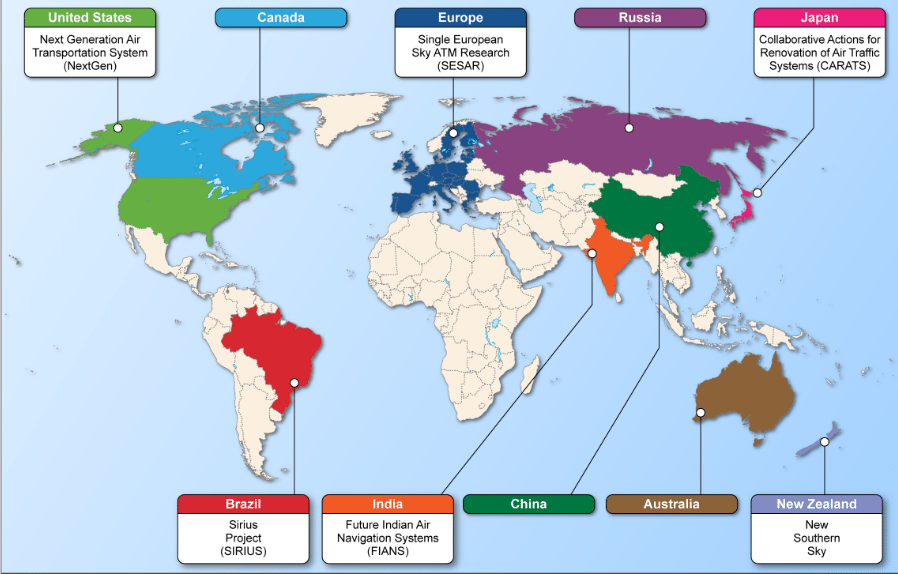 |
| Map of the ATM modernization programs across the globe. Photo: GAO |
[Avionics Today 09-03-2015] The FAA could see big gains in implementation of its NextGen program should the organization invest more into developing international interoperability for the airspace modernization initiative, according to a recent report by the Government Accountability Office (GAO). A globally interoperable NextGen system would align the systems, procedures and technologies that are compatible with other countries’ Air Traffic Management (ATM) systems, many of which are seeing modernization efforts of their own, such as the European Union (EU), Australia, and Japan. By aligning these systems and standards, aircraft flying internationally could transition seamlessly between the airspace in the U.S. and other countries, which are also modernizing ATM.
“Interoperability is particularly important in helping minimize the cost of developing and implementing new ATM capabilities for aviation manufacturers and airlines,” said Heather Krause, acting director at the U.S. GAO. “Incompatible standards, procedures, or technologies between countries could lead to airlines having to implement multiple sets of technologies or procedures and manufacturers having to develop multiple technology solutions, with fewer potential customers for each.”
According to Krause, the industry stakeholders interviewed for the report believed interoperability would be particularly beneficial in NextGen systems involving data sharing, such as DataComm, a capability aimed at enhancing digital communications between pilots and air traffic controllers.
“FAA and the EU agreed to implement a more advanced digital communication infrastructure (referred to as the Aeronautical Telecommunications Network (ATN) Baseline 2) by 2025 but are taking different implementation approaches to get there,” explained Krause. “As implementation proceeds, FAA and the EU will have to work together to develop compatible standards for these future improvements.”
System Wide Information Management (SWIM), the NextGen infrastructure that aims to connect various networks among Air Navigation Service Providers (ANSPs) to provide a plane of information to all aviation stakeholders, would also see big benefits from increased cooperation. And, as it stands, the FAA is already making strides in this area.
“The FAA organized a demonstration of worldwide flight-information sharing that allowed FAA, flight operators, and other countries to test their ability to share real-time flight information using the network being developed for FAA (referred to as System Wide Information Management, or SWIM),” explained Krause. “The demonstration allowed FAA to determine whether its capabilities for exchanging aviation information were applicable globally and helped to identify issues and mitigations that are needed to ensure interoperability.”
The FAA plans to conduct its next major demonstration of SWIM in 2016.
The agency has made other strides toward interoperability as well, most notably alongside the EU when the two teamed up to provide International Civil Aviation Organization (ICAO) with a list of NextGen priorities and inventories of the standards to help develop and prioritize ICAO’s Aviation System Block Upgrades. The upgrades provide a flexible and scalable roadmap of ATM operational improvements that allow individual countries or regions to implement ATM modernization improvements as needed, based on its own determination or needs and resources, said Krause.
ICAO estimates that more than 50 percent of it’s 191 member countries have aligned their current ATM improvement programs with the ICAO block upgrades, including countries with significant air traffic growth such as China, India, and Brazil. In this way, while increased interoperability is important for aircraft flying international routes to ensure a seamless transition between airspace, there are also gains to be seen in sharing best practices between nations, the GAO report finds. Still, the report concludes there are several reasons why total interoperability isn’t feasible across the global ATM system — including gaps in financing capabilities, political conditions and differing opinions on a desired outcome for the modernization initiatives.
“FAA has taken a number of positive steps to better coordinate its NextGen interoperability efforts across the agency and continues to collaborate with international partners worldwide to ensure that NextGen is interoperable with other countries’ modernization efforts,” explained Krause. “FAA could develop a more effective strategy — within FAA and with international partners — if the agency took a more comprehensive approach to assessing and managing potential risks to NextGen interoperability, such as those resulting from the factors identified by the stakeholders that we interviewed.”
To enable this more comprehensive approach, however, the FAA will need a better system in place to vet possible risks that interoperability may pose. At present, the report finds that the organization is not well positioned to ensure that its strategy effectively mitigates these risks or allocates the proper resources to explore them.
“For a large-scale, highly complex undertaking like NextGen, FAA needs to have a clear understanding of risks … and potential impacts of those risks so the agency can prioritize its resources toward actions that will manage and mitigate those risks,” explained Krause. These risks include resource and finance constraints and the timing of implementation of ATM modernization efforts. One such example is SWIM. While the free exchange of data may enable countries to take part in better decision-making, some ANSPs may choose to limit access and, thus, limit the benefits of the system, posing a risk to interoperability.
“While reaching agreement may take time, if agreement is not reached, different standards or practices could be adopted in different countries and lead to increased costs for the aviation industry,” said Krause.